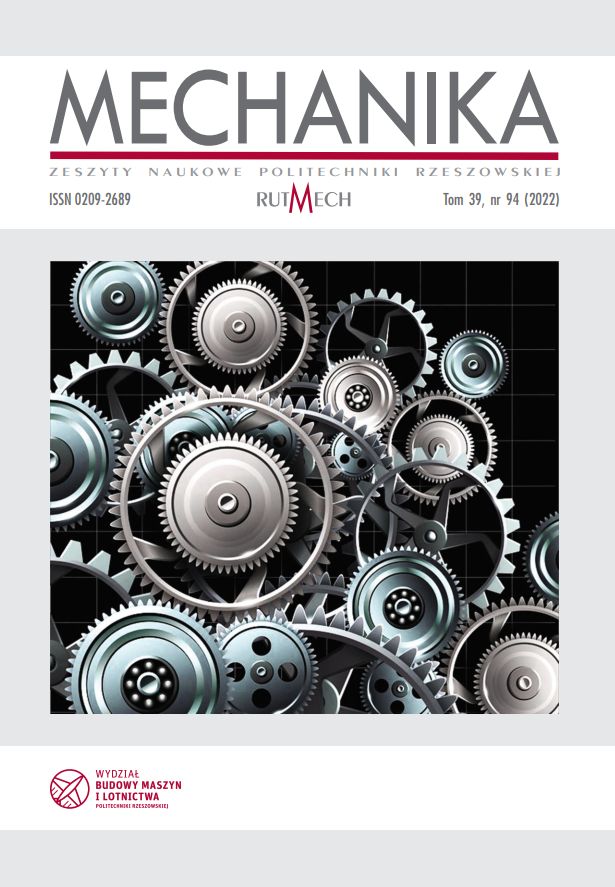Abstract
The article presents the results of friction tests conducted on EN AW-2024 Alclad aluminium alloy sheets. The lubrication efficiency of oleic acid, mineral and vegetable oils with the addition of SiO2 and TiO2 nanoparticles was determined using the strip drawing test to assess the friction conditions in the flange area
in the deep drawing process. The samples in the form of sheet metal strips were pulled between countersamples with a rounded surface at a speed of 2.5 mm/s. Gear oil and oleic acid demonstrated the lowest value of the coefficient of friction (COF) in the whole range of nominal pressures investigated. The lowest efficiency in reducing the COF was shown by hydraulic oil, olive oil and machine oil. A high content of TiO2 nanoparticles (0.5-0.9%wt%) is beneficial in the friction process involving oleic acid.
References
Abe, Y., Mori, K., Hatashita, F., Shiba, T., Daodon, W., & Osakada, K. (2016). Improvement of seizure resistance in ironing of stainless steel cup with cermet die having fine lubricant pockets. Journal of Materials Processing Technology, 234, 195-207. https://doi.org/10.1016/j.jmatprotec.2016.03.017.
Ahmad, N.A., Samion, S., Rahim E.A., & Jamir, M.R.M. (2020). Environmentally approach for enhancing tribological characteristics in metal forming: A review. Journal Tribologi, 26, 37-59.
Bay, N., Azushima, A., Groche, P., Ishibashi, I., Merklein, M., Morishita, M., Nakamura, T., Schmid, S., & Yoshida, M. (2010). Environmentally benign tribo-systems for metal forming. CIRP Annals, 59(2), 760-780. https://doi.org/10.1016/j.cirp.2010.05.007.
Carcel, A.C., Palomares, D., Rodilla, E., & Pérez Puig, M.A. (2005). Evaluation of vegetable oils as pre-lube oils for stamping. Materials Design, 26, 587–593. https://doi.org/10.1016/j.matdes.2004.08.010.
Cortes V., Sanchez K., Gonzalez R., Alcoutlabi M., & Ortega J.A. (2020). The performance of SiO2 and TiO2 nanoparticles as lubricant additives in sunflower oil. Lubricants, 8, 10. https://doi.org/10.3390/lubricants8010.
Dou, S., Wang, X., Xia, J., & Wilson, L. (2020). Analysis of sheet metal forming (warm stamping process): A study of the variable friction coefficient on 6111 aluminum alloy. Metals 10, 1189. https://doi.org/10.3390/met10091189.
Dou, S., Xia, J. (2019). Analysis of sheet metal forming (stamping process): A study of the variable friction coefficient on 5052 aluminum slloy. Metals, 9, 853. https://doi.org/10.3390/met9080853.
Fox, N.J., Stachowiak, G.W. (2007). Vegetable oil-based lubricants—A review of oxidation. Tribology International, 40, 1035–1046. https://doi.org/10.1016/j.triboint.2006.10.00.
Gulzar, M., Masjuki, H.H., Kalam, M.A., Varman, M., Zulkifli, N.W.M., Mufti, R.A., Zahid, R., & Yunus, R. (2017). Dispersion stability and tribological characteristics of TiO2/SiO2 nanocomposite-enriched biobased lubricant. Tribology Transactions, 60, 670–680. https://doi.org/10.1080/10402004.2016.1202366.
Hernández Battez, A., González, R., Viesca, J.L., Fernández, J.E., Díaz Fernández, J.M., Machado, A., Chou, R., & Riba, J. (2008). CuO, ZrO2 and ZnO nanoparticles as antiwear additive in oil lubricants. Wear, 265, 422–428. https://doi.org/10.1016/j.wear.2007.11.013.
Idegwu, C.U., Olaleye, S.A., Agboola, J.B., & Ajiboye, J.S. (2019). Evaluation of some non-edible vegetable oils as lubricants for conventional and non-conventional metal forming processes. AIP Conference Proceedings, 2113, 030004. https://doi.org/10.1063/1.5112532.
Krasowski, B. (2021) Analiza procesu kształtowania przyrostowego usztywnień
w cienkościennych konstrukcjach nośnych wykonanych ze stopów aluminium EN AW2024-T3 oraz EN AW-7075-T6. Rozprawa doktorska. Politechnika Rzeszowska.
Liñeira del Río, J.M., Guimarey, M.J.G., Prado, J.L., Lugo, L., López, E.R., & Comuñas, M.J.P. (2022), Improving the tribological performance of a biodegradable lubricant adding graphene nanoplatelets as additives. Journal of Molecular Liquids, 345, 117797. https://doi.org/10.1016/j.molliq.2021.117797.
Padgurskas, J., Rukuiža, R., Meškinis, A., Kreivaitis, R., & Spruogis, B. (2016). Influence of manufacturing methods on the tribological properties of rapeseed oil lubricants. Transport, 31, 56–62. https://doi.org/10.3846/16484142.2015.1048525.
Pang, H., Ngaile, G. (2020). Formulation of SiO2/oil nanolubricant for metal forming using hydrodynamic cavitation. Proceedings of the Institution of Mechanical Engineers, Part B: Journal of Engineering Manufacture, 234, 1549-1558. https://doi.org/10.1177/0954405420933120.
Peng, D., Chen, C., Kang, Y., Chang, Y. & Chang, S. (2010). Size effects of SiO2 nanoparticles as oil additives on tribology of lubricant. Industrial Lubrication and Tribology, 62, 111-120. https://doi.org/10.1108/00368791011025656.
Peng, D.X., Kang, Y., Hwang, R.M., Shyr, S.S., & Chang, Y.P. (2009). Tribological properties of diamond and SiO2 nanoparticles added in paraffin. Tribology International, 42, 911–917. https://doi.org/10.1016/j.triboint.2008.12.015.
Rao, K.P., Xie, C.L. (2006). A comparative study on the performance of boric acid with several conventional lubricants in metal forming processes. Tribology International, 39, 663–668. https://doi.org/10.1016/j.triboint.2005.05.
Rodrigues, J., Costa, I., Farinha, J.T., Mendes, M., & Margalho, L. (2020). Predicting motor oil condition using artificial neural networks and principal component analysis. Eksploatacja
i Niezawodnosc-Maintenance and Reliability, 22(3), 440- 448. http://dx.doi.org/10.17531/ein.2020.3.6.
Seshacharyulu, K., Bandhavi, C., Naik, B.B., SrinivasaRao, S.S., & Singh, S.K. (2018). Understanding friction in sheet metal forming-A review. Materials Today: Proceedings, 5(9), 18238-18244. https://doi.org/10.1016/j.matpr.2018.06.160.
Sigvant, M., Pilthammar, J., Hol, J., Wiebenga, J.H., Chezan, T., Carleer, B., & van den Boogard, T. (2019). Friction in sheet metal forming: influence of surface roughness and strain rate on sheet metal forming simulation results. Procedia Manufacturing, 29, 512-519. https://doi.org/10.1016/j.promfg.2019.02.169.
Vinay, K.U., Vinoth, M.A. (2014). Analysis of mechanical properties of pure aluminium based metal matrix composite. International Journal of Innovative Research & Studies, 3(5), 702-711.
Więckowski, W., Adamus, J., & Dyner, M. (2020). Sheet metal forming using environmentally benign lubricant. Archives of Civil and Mechanical Engineering, 20, 51. https://doi.org/10.1007/s43452-020-00053-x.
Yu, Z.Q., Hou, Y.K., Li, S.H., Lin, Z.Q., Zhang, W.G. (2010). Surface damage behavior of galvanized steel sheets in forming process under tension-bending. International Journal of Modern Physics B, 24(30), 5877-5884. https://doi.org/10.1142/S0217979210057481.
Zabala, A., Galdos, L., Childs, C., Llavori, I., Aginagalde, A., Mendiguren, J., & Saenz de Argandoña, E. (2021). The interaction between the sheet/tool surface texture and the friction/galling behaviour on aluminium deep drawing operations. Metals, 11, 979. https://doi.org/10.3390/met11060979.
Zareh-Desari, B., Davoodi, B. (2016). Assessing the lubrication performance of vegetable oil-based nano-lubricants for environmentally conscious metal forming processes. Journal of Cleaner Production, 135, 1198–1209. https://doi.org/10.1016/j.jclepro.2016.07.040.
Zavala, J.M.D., Martínez-Romero, O., Elías-Zúñiga, A., Gutiérrez, H.M.L., de la Vega, A.E., & Taha-Tijerina, J. (2021). Study of friction and wear effects in aluminum parts manufactured via single point incremental forming process using petroleum and vegetable oil-based lubricants. Materials, 2021, 14, 3973. https://doi.org/10.3390/ma14143973.


